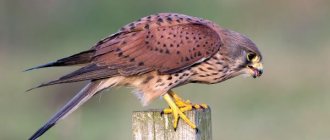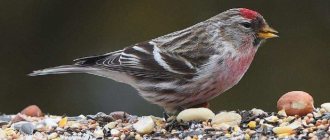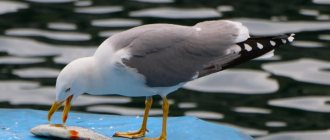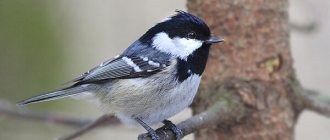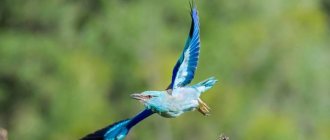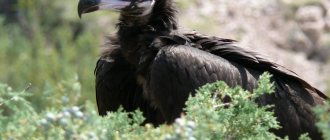The Egyptian sacred god named Djehuti, otherwise called Thoth (sometimes Tut or Tout), was always depicted with the head of an ibis bird. He was considered the one who gives his blessing to students of various sciences and writes books, sacred and ordinary. He was the god of wisdom, knowledge and the moon. But today we are not talking about the mythical deity itself, but about that sacred bird of ancient Egypt, which was the personification of this very wisdom and intelligence - the ibis.
Description
Appearance of the ibis bird
The ibis bird is small in size, weighing up to 4 kilograms and height 60-100 centimeters. Ibises have a slightly elongated, barrel-shaped body, set on long, thin, four-toed webbed feet. The flexible thin neck is of medium length, the head is slightly thrown back. Some ibises have a tuft of feathers or a rounded leathery growth on the top of their heads. The wings are long and wide, consisting of 11 main feathers, which allows the bird to reach speeds of up to 65 kilometers per hour in flight. The tail is short, barely noticeable. Unlike other storks, ibises lack a crop sac and powdery plumage.
Plumage
— Advertising —
Ibises have single-color plumage. There are species that are completely white. There are ibises with black, gray, emerald, and brown feather colors. A striking representative of the ibis family is the red (scarlet) ibis. The body, neck, head, tail and legs of this bird are painted in a burning red color.
Ibis walking on the lake
In some varieties of ibis, the main color is supplemented with a contrasting shade. For example, the black-faced ibis has a lead-colored body and a bright yellow neck; the white body plumage of the red-legged ibis contrasts with the bright red complexion; The black-headed ibis is colored off-white, while the tail and neck are dark gray. Young ibises are characterized by rich, bright feather color. With each moult, the color of the feathers fades.
Beak
Photo of an ibis close up
– Advertisement –
A distinctive feature of ibises is their beak. It is long, thin, and curved downward at the end. This part of the body is a hunting tool, so the bird’s beak is naturally very powerful and strong. In some varieties of ibis, the tip of the beak is slightly wider, which allows the birds to hunt aquatic life more effectively.
The birds plant their long beaks in the muddy bottom and, digging it up, search for and catch prey. Using their long beaks, they find food in rock crevices and deep burrows. The tongue is not involved in eating food, since it is atrophied due to evolution.
Appearance
There are about 30 species of ibises in the world. Of these, 5 live in Russia. Being the closest relatives of storks and herons. The birds resemble them in appearance with their characteristic features: thin long legs, compact body. Between three of the four toes there is a swimming membrane that helps them with their wetland existence.
The small head is connected to the body by a long neck, which gracefully extends during flight. Ibis species differ in the variety of plumage colors, the colors of which can vary from blood-scarlet to snow-white, inconspicuous gray. Some species have a crest on the back of the head.
Spreading
Area
A flock of ibises near a pond.
A large family of ibises is distributed throughout the world, with the exception of the northern regions. These are heat-loving birds that choose the tropics and subtropics to live, with rare exceptions, temperate latitudes. The largest number of ibises is concentrated on the east coast of Africa, northwest Latin America, and Australia. With rare exceptions, ibises settle in Europe and Russia.
Habitats
Ibises near the water
Ibises belong to the group of semi-aquatic birds. Birds prefer to nest near bodies of water, as they feed mainly on aquatic life. For nesting, birds choose open areas - forest edges, river valleys. Some species of ibis, such as the warty ibis, are not attached to bodies of water and make their home in dry places. They feed mainly on small vertebrates and plant matter. Ibises are found in steppes and savannas, rocky semi-deserts.
Ibis: migratory bird or not
The ibis flaps its wings.
Most species of ibis are migratory. Birds living in North America fly to Colombia, Ecuador and Venezuela in winter. European birds migrate to Africa and Asia during the cold season. Japanese birds fly to Australia for the summer. Other “southern” species lead a sedentary lifestyle, but in search of food they travel across the range, moving thousands of kilometers away from the nesting site.
Mating season
Birds are monogamous, forming a pair for the entire period of life. A pair of ibises does everything together: collects stems and twigs for the nest, takes turns incubating eggs and feeding the chicks. The nest is usually spherical in shape. It can be located in reed thickets, coastal grass or on a tree. The female lays eggs once a year. Northern ibises begin laying eggs in the spring. Southern species living in tropical and subtropical zones begin laying with the beginning of the rainy season.
Nutrition
Photo of an ibis in the desert
The diet of ibises consists of insects and small vertebrates. Birds hunt for mollusks, crustaceans, and larvae. Adults sometimes feast on larger prey - fish, eggs of small birds, frogs. Land ibises catch lizards, mice and earthworms. If possible, they eat beetles, snails, slugs, spiders and locusts.
In times of famine, ibises do not disdain to feed on carrion or the leftover food of predatory animals.
Notes
- ↑ Birds of Russia and adjacent regions. Volume 7. Pelican-shaped, Stork-shaped, Flamingiformes / resp. ed.: S. G. Priklonsky, V. A. Zubakin, E. A. Koblik. - M.: Partnership of Scientific Publications KMK, 2011. - P. 431-435. — 602 p. — ISBN 978-5-87317-754-7
- ↑ Boehme R.L., Flint V.E.
Five-language dictionary of animal names. Birds. Latin, Russian, English, German, French / Under general. ed. acad. V. E. Sokolova. - M.: Russian language, RUSSO, 1994. - 845 p. — 2030 copies. — ISBN 5-200-00643-0.
Lifestyle
A flock of ibises in the sky
Ibises are flocking birds. They live in colonies of 100-150 pairs. During nomadic migration, bird families unite into a huge flock, which numbers up to 1 million individuals. Birds fly together and create so-called “bird markets” in rest areas. Ibises are calm, peace-loving birds. They accept other birds into their flocks, for example, spoonbills, cormorants, herons. They all fly along the same route, and then also return home together. Thanks to their powerful long wings, ibises fly quickly and well. In one day they cover a distance of several hundred kilometers.
Photo of ibis
Ibises are diurnal. During daylight hours they hunt, leisurely wandering through shallow water and picking mud with their beaks in search of crustaceans or slugs. Having caught the prey, the bird makes a sharp swing of its head, picking up the food with its beak and swallowing it whole. Ibises are cautious birds. Sensing danger, they make a sharp flap of their wings and rise into the air with lightning speed, hiding from the enemy in the crown of trees or bushes. At night, ibises climb into their nests and rest.
Reproduction
Ibis family in a nest
Most ibis species are monogamous. By the age of three, young birds become sexually mature. Natural instinct forces them to look for a mate and begin breeding. Partners stay together throughout their lives. Together they share the burden of building a nest, incubating and raising offspring. The nesting period for northern birds begins in March and lasts until early May. Ibises, living in Australia and South America, breed from September to January - during the rainy season.
Ibises build nests in trees. Some species make their homes in thickets of reeds, reeds or papyrus. The nest is a wide, deep bowl assembled from flexible branches and stems. The “houses” are located close to each other - this way there is a greater chance of reacting in time to the appearance of a predator and flying away.
Photo of female male and chick ibis
The female ibis lays 2-6 eggs. They are twice the size of chickens. Some ibises have cream-colored eggs, while others lay light blue or grey-green eggs. The incubation period lasts three weeks. The female and male take turns incubating their offspring. The chicks are born small and helpless. They can’t see yet, but the body is covered with sparse grayish or brown wet down. Parents feed their young with insect larvae. On the fortieth day, the chicks begin to fly, but they leave their father’s house only after three months of life. In autumn, young birds unite in flocks and migrate along with adult birds. The plumage of one-year-old birds differs from mature ibises: it is not so bright and contrasting. Only in the second year of life, after the first molt, will the feather color become the same as that of adult birds. The average lifespan of an ibis is 18 - 20 years.
Links[edit]
- BirdLife International (2016). "Pseudibis papillosa". IUCN Red List of Threatened Species
.
2016
: e.T22697528A93619283. DOI: 10.2305/IUCN.UK.2016-3.RLTS.T22697528A93619283.en. - Blandford, W. T. (1898). Fauna of British India, including Ceylon and Burma. Birds. Volume 4. London: Taylor and Francis. pp. 362–363.
- Stettenheim, Peter R. (2000). "The integumentary morphology of modern birds—a review". American zoologist
.
40
(4): 461–477. DOI: 10.1093/ICB/40.4.461. - ^ a b Hancock, James; Kushlan, James A.; Kahl, M. Philip (2010). Storks, ibises and spoonbills of the world
. A&C Black. pp. 241–244. - ^ abcde Ali, Salim; Ripley, S. Dillon (1978). Handbook of the Birds of India and Pakistan
(2nd ed.). New Delhi: Oxford University Press. pp. 112–113. - ^ ab Baker, E. C. Stewart (1929). Fauna of British India, including Ceylon and Burma. Birds. Volume 6 (2nd ed.). London: Taylor and Francis. pp. 316–317.
- ^ abc Whistler, Hugh (1949). A Popular Guide to Indian Birds (4th ed.). London: Gurney and Jackson. pp. 497–498.
- ^ ab Rasmussen, P. C. & J. C. Anderton (2005). Birds of South Asia. Ripley's Guide. Volume 2
. Washington, DC and Barcelona: Smithsonian Institution and Lynx Edicions. pp. 65–66. - Oberholser, Harry S. (1922). "Inocotis Reichenbach will be replaced by Pseudibis Hodgson". 35
. [Washington, Biological Society of Washington]: 79. Cite journal requires |journal=(help) - Holyoake, David (1970). "Comments on the classification of Old World ibises". Bulletin of the British Ornithologists' Club
.
90
(3): 67–73. - Collar J, Nigel; Eames S, Jonathan (2008). "Head size and sex dimorphism in Pseudibis papillosa and P. davisoni" (PDF). BirdingASIA
.
10:36
. - ^ abc Hancock, James A.; Kushlan, James A.; Kahl, M. Philip (1992). Storks, ibises and spoonbills of the world
. Academic press. pp. 241–244. - Khan, Asif N. (2015-04-01). "Indian black ibis Pseudibis papillosa feeding on carrion." Journal of the Bombay Natural History Society
.
112
(1):28. doi:10.17087/jbnhs/2015/v112i1/92323. ISSN 0006-6982. - Johnson, J. Mangalraj (2003). "Black ibis Pseudibis papillosa feeds on frogs from crab holes". J. Bombay Nat. Hist. Soc
.
100
(1):111–112. - Inglis, C. M. (1903). “Birds of Madhubani Division of Darbhanga District, Tirhut, with Notes on Species Seen in Other Parts of the District. Part 6". Journal of the Bombay Natural History Society
.
15
(1): 70–77. - Mason, C. W. (1911). Maxwell-Lefroy, H. (ed.). Bird food in India. Imperial Indian Agriculture Department. pp. 280–280–282.
- Ali, AHMS; Kumar, Ramesh; Arun, P. R. (2013). "Black Ibis Pseudibis papillosa
nesting on power poles, Gujarat, India."
BirdingAsia
.
19
: 104–106. - Salimkumar, C.; Soni, W. K. (1984). "Laboratory observations of the incubation period of the Indian black ibis Pseudibis papillosa (Temminck)". J. Bombay Nat. Hist. Soc
.
81
(1):189–191. - Hume, A. O. (1890). Nest and eggs of Indian birds. Volume 3 (2nd ed.). London: R.H. Porter. pp. 228–231.
- Inglis, William G. (1954). “On some nematodes of Indian vertebrates. I. Birds." Annals and Journal of Natural Science
.
12. 7
(83): 821–826. DOI: 10.1080/00222935408651795. - Tandan, B. K. (1958). "Mallophagan parasites from Indian birds - Part V. Species belonging to the genus Ibidoecus Cummings, 1916 (Ischnocera)" (PDF). Proceedings of the Royal Entomological Society of London
.
110
(14):393–410. DOI: 10.1111/j.1365-2311.1958.tb00379.x. - Faltynkova, Anna; Gibson, David I.; Kostadinova, Aneta (2008). "A revision of Patagifer Dietz, 1909 (Digenea: Echinostomatidae) and a key to its species." Systematic parasitology
.
70
(3): 159–183. DOI: 10.1007/s11230-008-9136-8. - Odening, Klaus (1962). "Trematoden aus indischen Vögeln des Berliner Tierparks". Zeitschrift für Parasitenkunde
(in German).
21
(5): 381–425. DOI: 10.1007/BF00260995. - Chauhan PP S, Bhatia BB (1970). "Eimerian mucilages from Pseudibis papillosa". Indian Journal of Microbiology
.
10
(2): 53–54. - Krishnan, M. (1986) Anril. Reprinted without credit in Nature's Spokesman
(2000), edited by Ramachandra Guha. Oxford University Press. pp. 93-95. - Varadarajan, Munuswamy (1957). Nature's Cure in Sangam Literature. Tirunelveli: Publishing Society of Saiva Siddhanta Works of South India. item 260.
- Jump up
↑ Dave, K. N. (1985).
Birds in Sanskrit Literature
. New Delhi: Motilal Banarsidass. item 384. - ^ ab Birds of India. Volume 3. Calcutta: George Wyman and Co. 1864. pp. 769–770.
- Le Messurier, A. (1904). Game, Shores and Waterfowl of India (4th ed.). London: W. Thacker and Co., pp. 183–184.
- Dewar, Douglas (1920). Indian Birds - Key to Common Plains Birds of India. London: John Lane. paragraph 217.
- Burton, Richard F. (1852). Falconry in the Indus Valley. London: John Van Vorst. pp. 57–58.
- Brower, Cohen; Shifter, Herbert; Jones, Marvin L. (1994). "Records of the longevity and breeding of ibises and spoonbills in captivity." International Yearbook of Zoos
.
33
: 94–102. DOI: 10.1111/j.1748-1090.1994.tb03561.x.
Kinds
There are 13 genera of ibises, which include 29 species of these birds. The most studied ibises are of the black-necked, bald-legged, red-footed, and forelock genera.
Sacred ibis (Threskiornis aethiopicus)
Photo of the sacred ibis
Genus: black-necked ibises
Appearance: a bird 75 centimeters high, weighing up to 2.5 kilograms. The plumage is white, the ends of the flight feathers, as well as the legs and beak are black with a purple tint. In older individuals, the neck and head are bare.
Distribution: The sacred ibis breeds in the southeast of the African continent, in Australia and Iraq. A couple of centuries ago, during a nomadic migration, he flew to the southwest of Russia (Kalmykia, Astrakhan region). 900-1000 pairs of ibises live in Europe.
Features: In ancient Egypt, the sacred ibis personified wisdom and intelligence. Ibises were worshiped and hunting them was prohibited.
Black-headed ibis or Indian ibis (Threskiornis melanocephalus)
Photo of black-headed ibis
Genus: black-necked ibises
Appearance: a bird whose height does not exceed 90 centimeters and weighs 1.3-1.5 kilograms. The body is painted off-white. The front of the neck and head are bare, the skin is black.
Distribution: The black-headed ibis lives in southern Asia - India, Thailand, Burma, Pakistan.
Features: the closest relatives of the black-headed ibis are the sacred and Moluccan ibises. All three species are migratory.
Warty ibis (Pseudibis papillosa)
Photo of warty ibis
Genus: pseudibis
Appearance: large bird with dark plumage. The wings and tail are dark blue with brown splashes, the body is brown. On the black head there is a red leathery “cap”. The iris of the eyes is orange, the beak is gray-green. There are white spots on the elytra.
Distribution: The warty ibis breeds in Hindustan.
Features: unlike other species of ibis, the warty one is not so attached to bodies of water, as it mainly feeds on terrestrial animals. Looks for food in dry areas.
Giant ibis (Thaumatibis gigantea)
Photo of a giant ibis
Genus: thaumatibis
Appearance: bird height – 100 centimeters, length – 102-106 centimeters, weight – 3.8-4.2 kilograms. The body and tail are dark brown with a dirty green tint. The legs are red, the beak is gray-yellow. The skin on the head and neck is greyish. The eyes are dark red.
Distribution: The habitat of the giant ibis is the border of Cambodia and Laos.
Features: The giant ibis is the national symbol of Cambodia. The species is on the verge of extinction and is listed in the International Red Book.
Forest ibis (Geronticus eremita)
Forest ibis photo
Genus: bald ibises
Appearance: The plumage of the forest ibis is black, with purple, blue and green shades on the wings. The legs and beak are pale pink. On the head is a crest of long thin thread feathers.
Distribution: the species previously lived in the Mediterranean and Europe. Now it is not found in the wild in these areas. Wild ibises survive in Morocco, Turkey and Syria.
Features: the forest ibis is similar in habits and habitat to the bald ibis. The species is distinguished by a crest on the head, which the bald ibis does not have. Although the forest ibis is not divided into subspecies, the population living in Morocco differs from the Turkish one in having a longer, curved beak.
Red-footed ibis or Japanese ibis (Nipponia nippon)
Red-footed ibis photo
Genus: red-footed ibis
Appearance: white bird with soft pink and grayish tints. The face and legs are bright red, the beak is dark gray, with a red tip. The iris of the eyes is yellow. The crest on the back of the head is made of long feathers and is dirty white. During the mating season, the plumage becomes grayish. Adult birds weigh 1.5 kilograms and are 80-90 centimeters tall.
Distribution: A couple of hundred years ago, the red-legged ibis nested in Central China, Japan and the Russian Far East, but due to ibis hunting and deforestation, the ibis population in these areas almost disappeared. Today, a few families of ibises are found in the Amur and Primorye regions, Korea, and China.
Features: According to ornithologists, there are 6-20 red-footed ibises left in the world. This species is extremely rare.
White-necked ibis (Theristicus caudatus)
Photo of white-necked ibis
Genus: white-necked ibises
Appearance: a bird whose height reaches 76 centimeters and weighs between 1.5-2 kilograms. The short feathers on the neck and head are brownish-yellow, the crest on the top of the head is dark brown. The body is fawn in color, the feathers along the edge are whitish. The beak is dark gray, the legs are dark red. There are black feathers around the eyes.
Distribution: The white-necked ibis breeds in northwestern Latin America. The most common species is in Venezuela, Colombia and Guiana. The ibis is found in the humid forests of Brazil and Northern Argentina.
Features: The number of the species is estimated between 25 thousand and 1 million birds.
Red ibis (Eudocimus ruber)
Photo of red ibis
Genus: Eudocimus
Appearance: The red ibis is a fiery red color. The bird grows up to 70 centimeters in height and weighs 1.5 kilograms. There is no sexual dimorphism.
Distribution: The red ibis is distributed in the north of the South American continent, as well as on the island of Trinidad.
Features: The red ibis lives in colonies. Settles mainly near water bodies. Monogamous.
Karavaika (Plegadis falcinellus)
Photo of loaves
Genus: loaves
Appearance: medium sized ibis. Body length does not exceed 65 centimeters, body weight – 500-900 grams. An adult bird is dark brown with black streaks. Feathers in the sun cast bronze and green shades. Young animals have a white stripe on their necks, which disappears with age.
Distribution: Numerous species of locusts are distributed in Eurasia, Africa, Australia and North America. In Russia, locusts settle along rivers, in particular, they nest in the deltas of the Kuban, Volga, and Terek. For the winter, locusts fly to Africa and South Asia.
Peculiarities: loonies choose swampy shrubland as their habitat. They live in flocks of 50-70 pairs.
Chubby ibis (Lophotibis cristata)
Photo of the forelock ibis
Genus: forelock ibises
Appearance: bird height 50-60 centimeters, weight – 480-980 grams. The plumage contains brown, black and white colors. Black head with a green tint, bare face red. Tuft feathers are black mixed with white. The beak is gray-yellow.
Distribution: The long-tailed ibis lives in Madagascar.
Features: The forelock ibis leads a sedentary lifestyle. Lives in flocks near water bodies. The breeding season occurs during the rainy season - from September to January.
Literature
- Article of the same name in MNME
Chapter 11 IBIS WHY IS IBIS THE WORST OF ALL? Aristotle. History of animals. IX. 27. 103. Cicero. On the nature of the gods II 50. Plutarch. About Isis and Osiris. 75. Plutarch. Table conversations. IV. 5. 2. Strabo. Geography. XVII. 2. 4. Elian. About the nature of animals. X. 29 “Physiologist”, p. 150. Timothy from Gaza. About animals. 39. 1. Isidore of Seville. Etymologies. XII. 3. 3. Aldhelmi Opera. (MGH, p 135). English bestiary, l. 63 Dicta Chrisostomi, l. 34 rev. Philip Tansky. Bestiary. 2631—2748.
Natural enemies of ibises
The hyena is the enemy of the ibis.
Adult ibises do not have as many enemies as their smaller counterparts. If the nests are located on the ground, then foxes, wild boars, hyenas and raccoons encroach on the eggs and chicks. Newly hatched babies are hunted by rats and ferrets. True, this rarely happens, since adult ibises carefully guard the brood and, if necessary, repel attacks from predators. Young ibises are hunted by birds of prey. Hawks, eagles and kites do not risk contacting adult ibises, directing all their attention to young birds that are just learning to fly and do not yet know how to defend themselves.
The hawk is the enemy of the ibis
The main enemy of the ibis is man. Agricultural activities, drying up of water bodies, deforestation, hunting - these factors have led to a serious reduction in the number of ibises. Most of the species in the family are on the verge of extinction. About 10 thousand years ago, the species of flightless bird Xenicibis xympithecus disappeared from the face of the earth as a result of uncontrolled human hunting.
Dangerous limit
Being predators themselves, ibises are often hunted by other birds: kites, eagles, and hawks. They are hunted by foxes, wild boars, and hyenas, who also destroy nests.
A large number of ibises die due to poor ecology: the complete disappearance of their habitat, the draining of water bodies, and the burning of vegetation along river banks. This led to the almost complete extinction of some species and put other ibises on the brink. The population of some species of ibis (red-footed, Japanese) is being restored in special centers for the protection of these birds.
Ibis in Egyptian culture
Ibis - the sacred bird of Egypt
The ancient Egyptians revered ibises. The inhabitants of Egypt invariably depicted the god of wisdom and justice Djehuti (Thoth) with the head of an ibis. In ancient times, ibises lived throughout Egypt. Every year, the birds chose the valleys of the Nile River as their nomadic destination. Ibises also lived in cities, walking freely through the streets and not being afraid of people. Dead birds were embalmed, some were buried with their owners. Archaeologists have found mummified remains of ibises in the Temple of Thoth, as well as numerous images of birds on the walls.
Thoth - god of knowledge in Ancient Egypt
Scientists believe that the Egyptians worshiped the so-called “sacred ibises” (by the name of the species), but there is an opinion that in ancient times another species of bird nested in Egypt - the forest ibis, which was the symbol of the country. Later, the forest ibis was replaced by birds with white plumage and a black head, which were given the name “sacred”. Today in Egypt, ibises are extremely rare, but in southeast Africa (Ethiopia, Kenya, Tanzania) the ibise population is large.
Christianity
a symbol of carnal desire, impurity, laziness.
Timofey from Gaza believes that the actions of the ibis are reasonable, and the “Physiologist” blames the ibis for its inability to swim and catch clean fish for food.
The early Christian text "Physiologus", as well as the medieval "Bestiary", notes that the ibis cannot swim and therefore devours dead fish near the shore. He brings the latter, and even snakes, as food for his cubs. “This ibis is the worst of all, for its shoots are sinful from sinners” (“Physiologus”).
“The unclean animal according to the Law is the ibis. He does not know how to swim, and lives near the banks of rivers and ponds, and cannot enter the depths where clean fish live. Interpretation. Learn to swim mentally in order to enter the depths of the mental river, into “the depths of the wealth, wisdom and mind of God.” For if someone does not stretch out both hands upward and make the sign of the cross, he cannot swim across the sea of passions. For the sign of the cross extends to all created things. The sun, if it does not extend its rays, cannot shine. The moon, if it does not spread its horns, does not shine; the bird of heaven, if it does not spread its wings, does not fly. Moses stretched out his arms and defeated Amalek, Daniel - the lions, Jonah in the belly of the sea monster, Thekla, thrown into the fire, among the animals and seals - and the sign of the cross saved her. Sussana from the elders, Judith and Esther from Holofernes and Artaxerxes, the three youths in the fiery furnace were saved by faith. The worst of all is the ibis. Sins are the fruit of sinners” (“Physiologist”, p. 150).
It is absolutely not clear why the ibis is worse than all - lions, seals and sea monsters. It is equally unclear what the connection is between the ibis and the three youths, Susanna and Judith? It may well be that “sins are the fruit of sinners,” but an even greater sin is theological nonsense.
The article about the ibis is a typical example of symbolic interpretation. The fact that the content of the Physiologist bears the stamp of Old Testament injunctions denying the religious values of the ancient Egyptians is confirmed by Origen’s next guess. According to Origen, evil demons choose as their place of residence the bodies of animals, the most predatory, wild and harmful, or act on the imagination of certain animals and force them to fly here or there, so that people, blinded by this broadcasting power, do not seek God. “When classifying animals,” writes Origen, “Moses established a special sign by which all those animals that the Egyptians and other peoples consider to be seers should not be considered unclean, and vice versa - all other animals in general should be considered pure. Moses classifies the wolf, fox, dragon, eagle, hawk and the like as unclean. And you will find that almost everywhere, not only in the Law, but also in the Prophets, these animals are always presented as the image of all the worst, and that in the application to the wolf or the fox there is never any indication of their actions in a good direction. […] And pay attention to what extent the impurity of demons extends: some of them even use the services of a swallow to discover the future this way” (Origen. Against Celsus. IV. XCIII).
“Like ibises, those carnivorous-minded people who greedily consume the deadly fruits of their deeds as food, and even feed their children with them, to their damage and destruction” (Unterkircher).
Interesting Facts
Chubby ibis on a branch
- The legend of Noah's Ark mentions the ibis bird, which, after the end of the flood, led Noah to the upper Euphrates, where Noah settled with his family.
- The oldest ibis is 60 million years old.
- The burning red color of the plumage of red ibises is explained by the fact that the shells of crayfish, which the birds eat, contain the coloring pigment carotene.
- The red-legged or Japanese ibis is the rarest bird species on earth. The population size is 8-11 birds.
Parasites[edit]
Nematode Belanisakis ibidis
has been identified from the small intestine of this species [20], while ibis feathers are host to certain species of bird lice in the genus
Ibidoecus
.
The species found in the red-naped
is
Ibdidoecus dennelli
.
[21] Patagifer chandrapuri
, a species of Digenea flatworm, was found in the intestines of individuals from Allahabad.
[22] In captivity, the fluke Diplostomum ardeiformium
has been described from a red-naped ibis host.
[23] Protist parasites include organisms like Eimeria
. [24]


